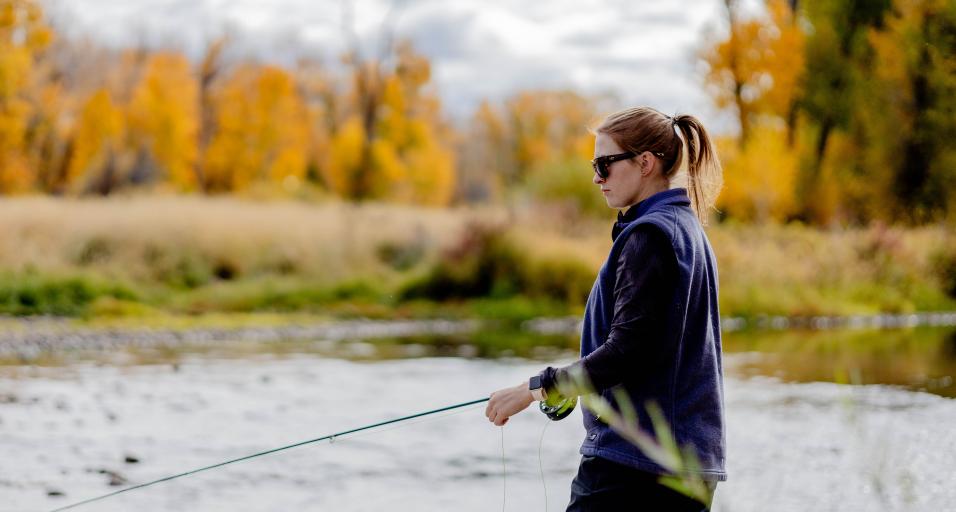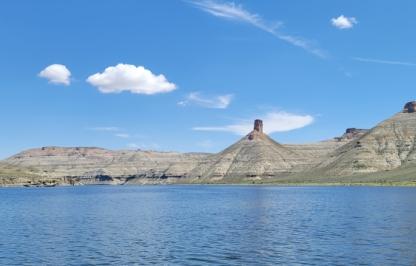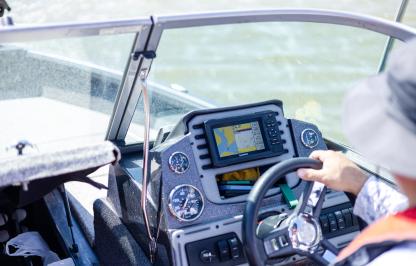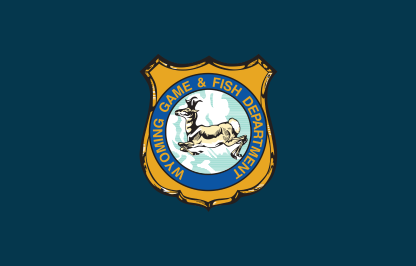CHEYENNE – There are a lot of options and diversity when it comes to fall fishing in Wyoming. From walleye to trout and northern pike to kokanee salmon, there are ample opportunities for anglers to enjoy the state’s bountiful fishing resources. Here is a fall fishing forecast from Wyoming Game and Fish Department fisheries supervisors and biologists from the department’s eight regions.
Lander Region
Boysen Reservoir has been a hot spot for walleye this year for fish in the 17-19-inch range, which are from the exceptional 2018 year class, and less than 15 inches, which are from above average year classes in 2021 and 2022.
“The high number of smaller, younger fish is good news for walleye fishing in the coming years,” said Paul Gerrity, Game and Fish fisheries biologist in the Lander Region.
The Popo Agie River should be good for brown and rainbow trout as above-average snowpack the last couple of years has created good stream habitat.
Shoshone Lake is a popular brook trout fishery in the Shoshone National Forest near Lander. Access requires an ATV/UTV or jeep. Brook trout numbers were good in 2024, with fish averaging close to 13 inches and some around 16 inches.
Louis Lake near Lander provides a unique fishery with kokanee salmon and lake trout. Kokanee have been stocked annually since 2015, but sampling in recent years shows fewer kokanee and more lake trout in the 8-20-pound range. Anglers are encouraged to harvest large lake trout. Regulations state anglers can harvest six lake trout and splake in combination, with only one trout or splake exceeding 24 inches.
The East Fork of the Wind River is a good spot to target Yellowstone cutthroat trout. Numbers generally increase as you travel upstream, and fishing can stretch into early November depending on weather conditions. All streams in the East Fork drainage allow fishing by artificial fly and lure only, and all cutthroat trout must be released to the water immediately.
Brooks Lake near Togwotee Pass offers spectacular views and great rainbow trout fishing. There also is the opportunity to catch brook trout, lake trout and splake.
Lake Cameahwait, also called Bass Lake, is a good place for largemouth bass, which often feed on yellow perch in the fall.
Pete’s Pond east of Dubois is a quality community fishery for anglers of all ages. It is stocked with rainbow and Yellowstone cutthroat, and also features an ADA-accessible fishing pier and walking path for easy access around the entire pond.
Casper Region
Walleye fishing picks up on all the major reservoirs in the region as water temperatures cool down. Glendo Reservoir offers excellent fall walleye fishing with the added bonus of relatively light fishing pressure. In addition, anglers often catch crappie and catfish as predators are all together feeding on gizzard shad.
Walleye fishing at Pathfinder and Seminoe reservoirs also heats up with cooling water temperatures. Fishing pressure on these lakes is lower than Glendo. The average size of walleye is smaller at Pathfinder and Seminoe — around 13 inches — than Glendo.
However, these reservoirs grow larger individual walleye than Glendo. Anglers wishing to target walleye 25-35 inches should fish large baits around rocky structures, especially around boat ramps. People usually find fast action trolling worm harnesses or crankbaits over sandy bottoms in 8-15 feet of water.
Trout fishing on area reservoirs also picks up in the fall. Shore fishing around Alcova Reservoir can be productive for rainbows and cutthroat. Kokanee salmon start cruising the shorelines in September looking for areas to spawn. Boat angling for trout at Alcova is especially good in the fall. Anglers fishing dodgers or cowbells with small spinners or hoochies should focus on trolling 10-20 feet below the surface. Another great technique is to throw jigs into steep, rocky shorelines. This technique produces trout and walleye.
All reaches of the North Platte River fish great in the fall. Insect hatches ramp up as the water cools, giving anglers excellent dry fly fishing opportunities. Fishing streamers also become more productive. Similar to other regional fisheries, fishing pressure tapers off significantly in the fall, with the exception of the Miracle Mile where the run of brown trout into the river from Pathfinder Reservoir is popular among anglers.
Green River Region
If you want to help improve one of the state’s most productive fisheries, head to Flaming Gorge Reservoir. Wyoming’s largest reservoir will be a hotspot for smaller lake trout.
“We have a lot of data that suggests smaller lake trout are taking a toll on the kokanee salmon recruitment in the reservoir,” said Robb Keith, Game and Fish fisheries supervisor in the Green River Region. “Every small lake trout harvested is a savings in juvenile kokanee and the trout we stock. Regulations on small lake trout are liberal.”
Over the last few years, Game and Fish has identified at least six segments of shoreline where smaller lake trout gather to spawn in depths from 10-70 feet as early as Oct. 10. The spawn is usually in full-swing by mid-October and typically lasts two to three weeks. Game and Fish has maps with locations where anglers can target these fish. The maps are posted on the Flaming Gorge Fishery Management page on the Game and Fish website, along with other helpful information.
Lake trout stay in shallow water and remain vulnerable to anglers into early November.
Most, but not all, of the spawning locations are on the east side of the reservoir and are most easily accessed by boat. However, some spawning areas can be accessed on foot. The spawning areas go from the south end of Big Bend to Boars Tusk in Utah. Small lake trout gravitate to the gravel, cobble slopes and submerged ridges that are 30 degrees or steeper.
Above water, look for gravel and small cobble slides on steeper slopes and ephemeral draws that cut through cliffs. When these features transition from land to water they create areas for small lake trout to spawn. Cast lures to the water’s edge and work the lure back close to the bottom until it is directly under the boat.
Keith said one-quarter ounce or three-eighth ounce black, white and luminescent grub body jigs work well when doing this. Sometimes heavier jigs are necessary if the fish are deep. The same jigs also work well fished vertically in 10-60 feet of water over structures such as submerged ridges and gravel slopes. Tipping the jigs with a small piece of sucker meat can help, especially when vertical jigging.
Jackson Region
“Fall is always a good time to fish the area's rivers,” said Darren Rhea, Game and Fish fisheries supervisor in the Jackson Region. “Temperatures are generally cooler in the morning, and as they warm up during the day the bug life can really get active. There are some great hatches in the fall and the cutthroat will really key in on them.”
Area lakes also provide opportunities for trout in the fall. Trout activity will typically increase along the shoreline as water temperatures drop — a great opportunity for shore anglers. Lake trout, brown trout and cutthroat trout become more available and eager during the fall, which isn’t the case at other times of the year.
There are liberal limits on lake trout less than 24 inches long in some lakes, giving anglers an option to bring home some tasty fish.
Rhea said Jackon and Jenny lakes are common places to go after these small lake trout, but more adventurous anglers can try Bradley, Taggart or Phelps lakes.
Sheridan Region
“Fall fishing can be some of the best fishing all year,” said Paul Mavrakis, Game and Fish fisheries supervisor in the Sheridan Region.
Keyhole Reservoir is expected to be good for 14-18-inch walleye and northern pike up to 40 inches long. However, crappie numbers are down with the high numbers of walleye and pike.
Healy Reservoir near Sheridan has a growing number of walleye, abundant populations of largemouth bass and small yellow perch and a chance for anglers to catch a good-sized tiger muskie. Outboard motors in excess of 15 horsepower are prohibited.
Kokanee salmon and rainbow trout numbers are increasing at Lake DeSmet near Buffalo with reports of anglers catching kokanee up to 18 inches long. Anglers need to fish deep for kokanee. Anglers are encouraged to harvest lake trout from DeSmet.
Muddy Guard Reservoir #1 is managed a trophy trout fishery, and nearby Muddy Guard #2 has responded well from a renovation project a few years ago and has some nice-sized rainbow and tiger trout.
For stream anglers, Sand Creek near Beulah has a lot of small brown trout, along with some good-sized browns and rainbows. North Tongue River trout populations appear to be better than in recent years, but are still down from the numbers 5-10 years ago. Game and Fish encourages anglers to harvest small brook trout found in many of the small streams in the Bighorn Mountains. Fewer fish in these densely populated streams generally results in better condition for the remaining fish.
Cody Region
Fall brown trout fishing is once again expected to be good throughout the region.
Shell, Paintrock and Medicine Lodge creeks are worth a try, along with the South Fork of the Shoshone River and lower Shoshone River closer to Cody.
“The brown trout streams in the fall can be exceptional because the fish are aggressive and hardly anyone is out there,” said Sam Hochhalter, Game and Fish fisheries supervisor in the Cody Region.
Hochhalter added as browns move up from lower segments of those creeks to more suitable spawning habitat, anglers have a better chance of catching larger fish than in the summer.
Hochhalter said the lower Shoshone River is in its prime during the fall months and continues to fish well into the winter months.
The Bighorn River near Thermopolis usually comes back to life in the fall following warm-water temperatures during the summer.
Hochhalter said there were low flows in the Bighorn River all summer, and the migration of sauger from the river to Bighorn Lake is expected to happen earlier than the last couple of years. That could mean good fishing for sauger in the lake this fall.
Laramie Region
Try going after splake in the Snowy Range Mountains. Splake, a sterile hybrid of brook and lake trout, have been stocked in many waters in the Snowys for many years to suppress sucker or stunted brook trout populations. Large splake are netted every year.
“While large splake are not abundant, they do exist. These large fish primarily feed on other fish, so try using lake trout tactics,” said Bobby Compton, Game and Fish fisheries supervisor in the Laramie Region.
Compton added some lakes to try for splake in the Snowies include Big Brooklyn, Carbon South Twin, Klondikes, Lewis, Marie, Mirror and Turpin.
Another Snowy Range lake — Lake Owen — is producing a nice mix of brook, brown, cutthroat and rainbow trout that are growing to nice sizes.
The Laramie, North Platte and Encampments rivers — and their tributaries — are great places to fish for brown trout.
Twin Buttes Reservoir supports a robust population of brown trout. Game and Fish asks anglers to fill out the online creel survey each time they fish there. The goal of the survey is to evaluate the success of stocked rainbow trout.
Pinedale Region
Boulder Lake is a great option for fall kokanee fishing. Soda Lake brown and brook trout fishing also picks up as temperatures decrease. The catch rate might be slow but the fish could be large. Lake trout fishing in all of the Finger Lakes picks up in the fall, and anglers are encouraged to harvest smaller lake trout.
Mosquito, Rock Crib and Wagon Creek lakes should produce enjoyable spots for brook trout.
Hilda Sexauer, Game and Fish fisheries supervisor in the Pinedale Region, said community fishing ponds in Sublette County should fish well this fall and be good spots for kids to fish. Those ponds include Kids Fishing Pond, CCC Pond and Town Pond.
Fall fishing tips
For fly anglers, fall is a great time to capitalize on hatches of blue-winged olive mayflies, various caddisflies and often an abundance of terrestrial grasshoppers and ants.
Pay close attention to what you see coming off the water throughout the day, and try to match the hatch. A good place to start is a size 10-14 attractor dry fly, such as a humpy, trailed by a smaller — size 14-18 — attractor nymph pattern such as a Copper John.
For conventional anglers, fall often means downsizing lures and baits, and using lighter line to catch wary fish.
For trout, try small, bright spoons and kastmasters to stand out against fallen leaves drifting through the water. A fly-and-bubble also can be an excellent approach.
For largemouth bass, crankbaits and spinnerbaits cover a lot of water. As temperatures drop, slow down retrieves and experiment with soft plastics for slow-moving fish.
Look for the spawn
Several fish species in Wyoming, such as brown trout, spawn during the fall, and anglers should keep an eye out for nests — also called redds — on the river bottom to avoid wading through them. Redds are often identified by oval-shaped patches of abnormally clean gravel, which results from vegetation being removed as females use their tail to move the gravel and construct their nest.
Be bear aware
Areas of northwest Wyoming are home to a high density of grizzly bears, and anglers should carry bear spray while fishing. If camping, maintain a clean camp and use proper food storage. Try to avoid dense vegetation which prevents adequate line-of-sight, and make noise as you are walking.
Additional fishing resources:




